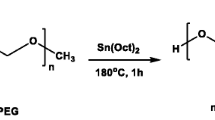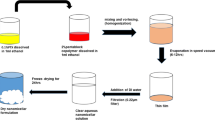Abstract
Paclitaxel (PTX) is one of the most utilized anticancer drugs with a broad spectrum of antitumor activity. PTX is usually formulated in Cremopher EL because it suffers from low solubility in water and has many side effects. Low solubility leads to encapsulation and controlled release of PTX being a rough process. In this study, a simple method was used for nano-encapsulation of PTX into three different types of ultra-fine polymeric particles. These include poly (methyl methacrylate) (PMMA), poly (styrene) (PST) and poly (methyl methacrylate-co-styrene) (P(MMA-ST-AA)) with several monomer ratios. Different drug contents in the monomer have been investigated. Synthesis was performed via the mini-emulsion polymerization method, and the results proved that PTX was encapsulated into spherical ultra-fine PA/PS nanoparticles of approximately 19 nm.









Similar content being viewed by others
References
Wang F et al. (2008) Synthesis and Characterization of Star Poly(ε-caprolactone)-b-Poly(ethylene glycol) and Poly(l-lactide)-b-Poly(ethylene glycol) Copolymers: Evaluation as Drug Delivery Carriers. Bioconjug Chem 19(7):1423–1429
Tabatabaei Rezaei SJ et al. (2012) Multifunctional and thermoresponsive unimolecular micelles for tumor-targeted delivery and site-specifically release of anticancer drugs. Polymer 53(16):3485–3497
Sartori S et al. (2013) Biodegradable paclitaxel-loaded microparticles prepared from novel block copolymers: influence of polymer composition on drug encapsulation and release. J Pept Sci 19(4):205–213
Mora-Huertas C, Fessi H, Elaissari A (2010) Polymer-based nanocapsules for drug delivery. Int J Pharm 385(1):113–142
Miladi K et al. (2013) Drug carriers in osteoporosis: preparation, drug encapsulation and applications. Int J Pharm 445(1):181–195
Bettencourt A, Almeida AJ (2012) Poly(methyl methacrylate) particulate carriers in drug delivery. J Microencapsul 29(4):353–367
Larsson M et al. (2014) Nanocomposites of polyacrylic acid nanogels and biodegradable polyhydroxybutyrate for bone regeneration and drug delivery. J Nanomater 2014:9
Pinchuk L et al. (2008) Medical applications of poly(styrene-block-isobutylene-block-styrene) ("SIBS"). Biomaterials 29(4):448–460
Antonietti M, Landfester K (2002) Polyreactions in miniemulsions. Prog Polym Sci 27(4):689–757
Naveed Ahmed, N.M.A., Asad Ullah Khan, Haseeb Shaikh, Asghari Maqsood, Abdelhamid Elaissari, Biodegradable Polymer Particles for Theranostics Applications, in Encyclopedia of Biomedical Polymers and Polymeric Biomaterials 2015, CRC Press Encyclopedia p 8330.
Iqbal J et al. (2011) Development and in vivo evaluation of an oral drug delivery system for paclitaxel. Biomaterials 32(1):170–175
Wang X et al. (2012) Synthesis of β-cyclodextrin modified chitosan–poly(acrylic acid) nanoparticles and use as drug carriers. Carbohydr Polym 90(1):361–369
Li H et al. (2013) Reduction-responsive drug delivery based on mesoporous silica nanoparticle core with crosslinked poly(acrylic acid) shell. Materials Science and Engineering: C 33(6):3426–3431
Sarti F et al. (2012) Poly(acrylic acid)–cysteine for oral vitamin B12 delivery. Anal Biochem 420(1):13–19
Gagliardi M (2012) In vitro haematic proteins adsorption and cytocompatibility study on acrylic copolymer to realise coatings for drug-eluting stents. Materials Science and Engineering: C 32(8):2445–2451
Henry SM et al. (2006) pH-responsive poly(styrene-alt-maleic anhydride) alkylamide copolymers for intracellular drug delivery. Biomacromolecules 7(8):2407–2414
Feng M, Li P (2007) Amine-containing core-shell nanoparticles as potential drug carriers for intracellular delivery. J Biomed Mater Res A 80(1):184–193
Tölli MA et al. (2014) In vivo biocompatibility of porous silicon biomaterials for drug delivery to the heart. Biomaterials 35(29):8394–8405
Guyot A et al. (2007) Hybrid polymer latexes. Prog Polym Sci 32(12):1439–1461
Park I-K et al. (2010) Water-soluble heparin–PTX conjugates for cancer targeting. Polymer 51(15):3387–3393
Sharma US, Balasubramanian SV, Straubinger RM (1995) Pharmaceutical and physical properties of paclitaxel (Taxol) complexes with cyclodextrins. J Pharm Sci 84(10):1223–1230
Pfeiffer P, Rosenbauer E-U (2004) Residual methyl methacrylate monomer, water sorption, and water solubility of hypoallergenic denture base materials. J Prosthet Dent 92(1):72–78
Landfester K et al. (1999) Formulation and stability mechanisms of polymerizable miniemulsions. Macromolecules 32(16):5222–5228
Chern CS, Chen TJ, Liou YC (1998) Miniemulsion polymerization of styrene in the presence of a water-insoluble blue dye. Polymer 39(16):3767–3777
Capek I (2010) On inverse miniemulsion polymerization of conventional water-soluble monomers. Adv Colloid Interf Sci 156(1–2):35–61
Strickler F et al. (2010) In vivo and in vitro characterization of poly (styrene-b-isobutylene-b-styrene) copolymer stent coatings for biostability, vascular compatibility and mechanical integrity. Journal of Biomedical Materials Research Part A 92(2):773–782
Strickler F et al. (2007) Evaluation of poly (methyl methacrylate-bn-butyl acrylate-bmethyl methacrylate) as a stent coating for paclitaxel delivery. Polym Preprints 48:284
Richard RE et al. (2005) Evaluation of acrylate-based block copolymers prepared by atom transfer radical polymerization as matrices for paclitaxel delivery from coronary stents. Biomacromolecules 6(6):3410–3418
Wang L et al. (2015) Polymer hydrophobicity regulates paclitaxel distribution in microspheres, release profile and cytotoxicity in vitro. Powder Technol 275(0):77–84
Lundberg BB et al. (2003) A lipophilic paclitaxel derivative incorporated in a lipid emulsion for parenteral administration. J Control Release 86(1):93–100
Xu J et al. (2012) Design and characterization of antitumor drug paclitaxel-loaded chitosan nanoparticles by W/O emulsions. Int J Biol Macromol 50(2):438–443
Feng SS, Huang G (2001) Effects of emulsifiers on the controlled release of paclitaxel (Taxol®) from nanospheres of biodegradable polymers. J Control Release 71(1):53–69
Wang H et al. (2011) Enhanced anti-tumor efficacy by co-delivery of doxorubicin and paclitaxel with amphiphilic methoxy PEG-PLGA copolymer nanoparticles. Biomaterials 32(32):8281–8290
Yoshizawa Y et al. (2011) PEG liposomalization of paclitaxel improved its in vivo disposition and anti-tumor efficacy. Int J Pharm 412(1–2):132–141
Baruch-Teblum E, Mastai Y, Landfester K (2010) Miniemulsion polymerization of cyclodextrin nanospheres for water purification from organic pollutants. Eur Polym J 46(8):1671–1678
Jan CM et al. (2001) The relationship between leachability of polymerization initiator and degree of conversion of visible light—cured resin. J Biomed Mater Res 58(1):42–46
Jagadeesh G, Hiremath NSK, Palavalli SG, Rudani CG, Aitha R, Mura P (2013) Paclitaxel loaded carrier based biodegradable polymeric implants: Preparation and in vitro characterization. Saudi Pharmaceutical Journal 21:85–91
Sorina Alexandra Garea, A.G., FT-IR Spectroscopy and Thermogravimetrical Characterization of Prodrugs Based on Different Dendritic Polymers and Antitumoral Drug. Materiale Plastice, 2012. 49(1).
Champion JA, Katare YK, Mitragotri S (2007) Particle shape: A new design parameter for micro- and nanoscale drug delivery carriers. J Control Release 121(1–2):3–9
Abdulla HAN, Dias RF, Minor EC (2009) Understanding the enhanced aqueous solubility of styrene by terrestrial dissolved organic matter using stable isotope mass balance and FTIR. Org Geochem 40(5):547–552
Barandiaran I, Kortaberria G (2015) Selective placement of magnetic Fe3O4 nanoparticles into the lamellar nanostructure of PS-b-PMMA diblock copolymer. Eur Polym J 68(0):57–67
Sánchez-Silva L et al. (2010) Microencapsulation of PCMs with a styrene-methyl methacrylate copolymer shell by suspension-like polymerisation. Chem Eng J 157(1):216–222
Li M et al. (2009) Preparation, solubility, and electrorheological properties of carbon nanotubes/poly(methyl methacrylate) nanocomposites by in situ functionalization. Compos A: Appl Sci Manuf 40(4):413–417
Polymer Reaction Engineering, J.M. Asua, Editor 2007, Blackwell Publishing Ltd.
Vella-Zarb L, Baisch U, Dinnebier RE (2013) Small molecule, big difference: the role of water in the crystallization of paclitaxel. J Pharm Sci 102(2):674–683
Javier S. Castro, L.V.T., Rocio A. Silveyra, Carlos A. Martinez and Pierre A. Deymier, Negative impact of paclitaxel crystallization on hydrogels and novel approaches for anticancer drug delivery systems. 2011.
Mitra A, Lin S (2003) Effect of surfactant on fabrication and characterization of paclitaxel-loaded polybutylcyanoacrylate nanoparticulate delivery systems. J Pharm Pharmacol 55(7):895–902
Acknowledgments
The authors wish to thank Mr. Amin Imani for his useful discussions and Dr. Reza Kasrai for English editing.
Author information
Authors and Affiliations
Corresponding author
Rights and permissions
About this article
Cite this article
Rajaee, A., Farzi, G. Encapsulation of paclitaxel in ultra-fine nanoparticles of acrylic/styrene terpolymer for controlled release. Colloid Polym Sci 294, 95–105 (2016). https://doi.org/10.1007/s00396-015-3752-z
Received:
Revised:
Accepted:
Published:
Issue Date:
DOI: https://doi.org/10.1007/s00396-015-3752-z




